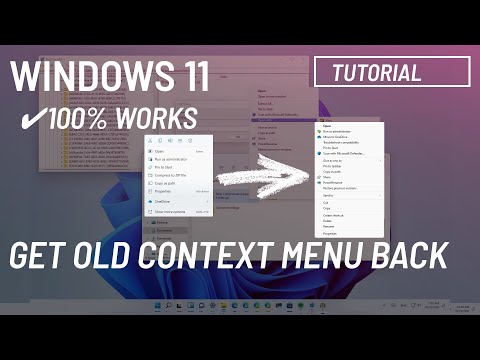Although Windows 11 introduces a redesigned right-click context menu that improves the old experience, the problem is that it’s limited in the options it can show compared to the classic menu. When you right-click an item, you can click on “Show more options” or use the “Shift + F10” keyboard shortcut to access the other entries, but it’s an extra step.
If the new Windows 11 menu design isn’t for you, it is possible to disable the new context menu to enable the classic right-click menu by editing the Registry directly or using Command Prompt.
In this guide, I will teach you the steps to get the context menu with all the legacy options on Windows 11.
Warning: It’s crucial to note that modifying the Registry can cause serious problems if not used properly. It’s assumed you know what you’re doing and created a full backup of your system before proceeding. Also, some users are reporting problems using these steps. You can check the video to confirm that the instructions worked to accomplish the task. However, it’s possible that future updates or the way you have configured your device may not be compatible with these changes. You should use these steps at your own risk.
To bring back the classic context menu on Windows 11, use these steps:
- Open Start on Windows 11.
- Search for regedit and click the top result to open the Registry.
- Navigate to the following path:
HKEY_CURRENT_USERSOFTWARECLASSESCLSID
- Right-click the CLSID key, select the New menu, and select the Key option.

- Name the key {86ca1aa0-34aa-4e8b-a509-50c905bae2a2} and press Enter.
- Right-click the newly created key, select the New menu, and select the Key option.

- Name the key InprocServer32 and press Enter.
- Double-click the newly created key and set its value to blank to enable the classic context menu on Windows 11.

Quick note: This step is crucial since if you don’t open and save the String with a blank (null) value, the switch may not work.
- Click the OK button.
- Restart the computer (important).
Once you complete the steps, whether you right-click on the desktop, file, or folder on File Explorer, the classic context menu will appear instead of the modern menu.
If you want to revert the changes to re-enable the modern context menu, you can follow the same instructions outlined above, but on step 4, right-click and delete the {86ca1aa0-34aa-4e8b-a509-50c905bae2a2} key and its contents.
The steps outlined above work as expected, but it’s been noted in the comments (by Reza Taba) that an even quicker way involves changing the Registry through Command Prompt.
To enable the classic context menu with commands, use these steps:
- Open Start.
- Search for Command Prompt, right-click the top result, and choose the Run as administrator option.
- Type the following command to enable the right-click context menu and press Enter:
reg add "HKCUSoftwareClassesCLSID{86ca1aa0-34aa-4e8b-a509-50c905bae2a2}InprocServer32" /f /ve
- Type the following command to close File Explorer and press Enter:
taskkill /f /im explorer.exe
- Type the following command to start File Explorer and press Enter:
start explorer.exe
After you complete the steps, you should be able to access the legacy right-click menu in File Explorer.
If you want to revert the changes, you can use the same instructions, but in step 3, run the reg delete "HKCUSoftwareClassesCLSID{86ca1aa0-34aa-4e8b-a509-50c905bae2a2}" command instead.
Microsoft also appears to be working on adding an option to make the classic context menu the default for Windows 11, but it’s unclear when and if this will happen.

